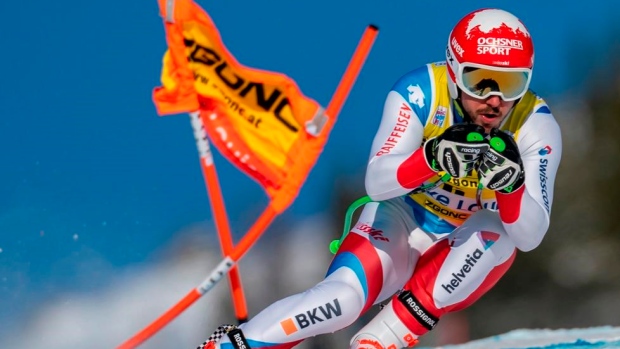Nov 29, 2019
Switzerland's Janka fast again in Lake Louise World Cup downhill training
Swiss veteran Carlo Janka was the fastest man in training a second straight day Friday and over two seconds quicker than his previous run. The men race super-G on Sunday following Saturday's downhill.
The Canadian Press

LAKE LOUISE, Alta. — The men's downhill course in Lake Louise offers something for every racer to like and loathe.
The traditional season-opener of the World Cup downhill season might not be the Hahnenkamm's white-knuckle ride in Kitzbuhel, Austria, but the Canadian track is tricky and unforgiving of even minor mistakes.
The course set for Saturday's downhill leaves even less margin for error, according to Norway's Kjetil Jansrud.
"My take is it's going to be an even tighter race due to the changes but it's fun to ski," said the man who won the downhill at the Alberta resort in 2014.
"If you set yourself apart it will be four or five tenths (of a second) instead of six, seven, eight.
"The difficulty in some ways goes down, but it's difficult enough to ski those sections perfectly. It's not about being easier or difficult. It's about being different. We're going to look for a more perfect execution now."
Swiss veteran Carlo Janka was the fastest man in training a second straight day Friday and over two seconds quicker than his previous run. The men race super-G on Sunday following Saturday's downhill.
The skiers unsurprisingly prefer the parts of the 3.1-kilometre track that suit their strengths.
Halfway down is where Lake Louise bares her teeth with a demanding section of turns and drops through checkpoints named Coaches Corner, Waterfall, Fish Net, Fall Away, C-Turn and Gun Barrel.
It's an area that claimed Canada's Manny Osborne-Paradis in last year's first training run. He flew into the safety nets at Fish Net and remains sidelined rehabilitating his broken leg.
"It's super-technical," Jansrud observed. "It's actually a difficult section for being on the World Cup. It kind of looks scary, but the flow-through is pretty nice. That's my favourite part."
Canada's Ben Thomsen also relishes that section, but is trying to master exiting it.
"It's actually steep and challenging," he said. "The least favourite is that single left foot at the bottom after Gun Barrel. I suck at it."
Both Jansrud and Toronto's Jack Crawford could do without the final stretch of gliding after Claire's Corner to the finish corral
"You're just sitting there, your legs hurt and you wish you were in the finish already," Jansrud said.
"Definitely Claire's Corner," Crawford concurred. "You're tired. It's just very straight and not much is going on. You're just hating life."
Lake Louise hosted its inaugural World Cup almost 40 years ago when Canadians Steve Podborski, Ken Read and Dave Irwin launched from the start hut in 1980.
The mountain resort in Banff National Park west of Calgary has been the site of 20 men's races and 28 women's races since then.
Read's son Jeff now races for the Canadian downhill team. The 22-year-old likes a flat section called upper Wiwaxy prior to Coaches Corner.
"I am my father's son and he was good glider," Read said. "That's kind of in my wheelhouse.
"Least favourite, it's got to be Fish Net because you're coming in there and, typically, the rest of the course is bright and Fish Net is dark. You can't really see the bumps. You get tossed around."
Austria's Max Franz is the defending downhill champion and Jansrud won last year's super-G.
Finishing in the top 30 is worth prize money and World Cup points on a descending scale. Each victor collects 45,000 Swiss francs (CDN$60,000).
Skiers ranked in the top 30 have the advantage of starting earlier than the remaining 30 to 40 racers on a smoother, more pristine course.
The majority on Canada's men's downhill team — minus 32-year-old Thomsen — are under the age of 23 and wanting to wedge themselves in the top 30.
"That's where I need to be this year," said 23-year-old Brodie Seger of North Vancouver, B.C.
"Consistently finishing in the points and getting into the top 30 on the World Cup start list."
The twenty-something Canadians may be inexperienced in downhill, but not at Lake Louise.
The host team chooses developmental racers to be course forerunners, who provide system checks for timers and television broadcasters prior to the race.
So the young Canadians racing the Lake Louise World Cup for the first, second or third times in their career Saturday had previous reps as forerunners.
It's an exhilarating and intimidating first taste of a World Cup course and race environment.
"I started forerunning this race when I was 15 or 16 at the time. I remember thinking 'why am I doing this?'" Seger recalled.
"My mom was asking the coach 'why are you putting my kid in this World Cup downhill? He's so young still.' His answer was simple. He said 'one day you're going to have to win this race so you better start practising it now.'"
Vancouver's Cameron Alexander, 22, will make his World Cup debut Saturday.
"It's nice that I'm on a track I'm pretty familiar with," he said. "It makes it a little more comfortable."
This report by The Canadian Press was first published Nov. 29, 2019.
